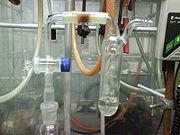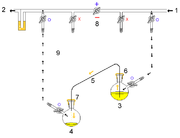
Oil bubbler
Encyclopedia

Laboratory glassware
Laboratory glassware refers to a variety of equipment, traditionally made of glass, used for scientific experiments and other work in science, especially in chemistry and biology laboratories...
which consists of a glass bulb filled with a small amount of fluid — usually mineral
Mineral oil
A mineral oil is any of various colorless, odorless, light mixtures of alkanes in the C15 to C40 range from a non-vegetable source, particularly a distillate of petroleum....
or silicone oil
Silicone oil
A silicone oil is any polymerized siloxanes with organic side chains. They are formed of alternating silicon-oxygen atoms or siloxane, rather than carbon atoms . Other species attach to the tetravalent silicon atoms, not to the divalent oxygen atoms which are fully committed to forming the...
, less commonly mercury. The inlet to the bulb is connected to a ground glass joint
Ground glass joint
Ground glass joints are used in laboratories to quickly and easily fit leak-tight apparatus together from commonly available parts. For example, a round bottom flask, Liebig condenser, and oil bubbler with ground glass joints may be rapidly fitted together to reflux a reaction mixture...
, while the outlet is vented to the air.
Gas bubblers are used to exclude air from a reaction or a system. In the former case, the gas bubbler is fitted on the condenser
Condenser (laboratory)
In a laboratory a condenser is a piece of laboratory glassware used to cool hot vapors or liquids. A condenser usually consists of a large glass tube containing a smaller glass tube running its entire length, within which the hot fluids pass....
of the reaction set-up. In the latter case, an oil bubbler is usually installed at the end of the inert gas
Inert gas
An inert gas is a non-reactive gas used during chemical synthesis, chemical analysis, or preservation of reactive materials. Inert gases are selected for specific settings for which they are functionally inert since the cost of the gas and the cost of purifying the gas are usually a consideration...
manifold on a Schlenk line
Schlenk line
225px|thumb|Vacuum gas manifold set up: 1 inert gas in, 2 inert gas out , 3 vacuum 4 reaction line, 5 Teflon tap to gas, 6 Teflon tap to vacuum 225px|thumb| Vacuum gas manifold set up: 1 inert gas in, 2 inert gas out , 3 vacuum , 4 reaction line, 5 double oblique stopcock...
to prevent contamination by atmospheric oxygen
Oxygen
Oxygen is the element with atomic number 8 and represented by the symbol O. Its name derives from the Greek roots ὀξύς and -γενής , because at the time of naming, it was mistakenly thought that all acids required oxygen in their composition...
and water
Water
Water is a chemical substance with the chemical formula H2O. A water molecule contains one oxygen and two hydrogen atoms connected by covalent bonds. Water is a liquid at ambient conditions, but it often co-exists on Earth with its solid state, ice, and gaseous state . Water also exists in a...
.
A gas bubbler acts as a one-way valve — gases (hot air, evolved gases, solvent vapors) from the inlet will bubble through the fluid before being vented to the atmosphere.
If there were an underpressure in the reaction vessel (such as when heat is removed, and the gases within contract), some fluid is sucked into a sump to equalize the pressure, instead of air. Wherever possible, such "suck back" should be avoided by filling the reaction apparatus with inert gas because an excessively low pressure will cause oil to be sucked into the reaction vessel, contaminating it.
The bubbles allow the worker to visibly confirm that the system is being flushed with inert gas; the rate at which bubbles form allow the worker to adjust the inlet pressure.
Oil bubblers
Oil bubblers are filled with mineralMineral oil
A mineral oil is any of various colorless, odorless, light mixtures of alkanes in the C15 to C40 range from a non-vegetable source, particularly a distillate of petroleum....
or silicone oil
Silicone oil
A silicone oil is any polymerized siloxanes with organic side chains. They are formed of alternating silicon-oxygen atoms or siloxane, rather than carbon atoms . Other species attach to the tetravalent silicon atoms, not to the divalent oxygen atoms which are fully committed to forming the...
. These are both quite resistant to chemical attack. Oil bubblers are predominantly used; the oil is inexpensive and not toxic.
A drawback is that due to oil's lower density, in event of underpressure in the reaction vessel, enough oil may be sucked through the sump into the inert gas system to contaminate it. Due to the same reason, the pressure within the inert gas system will always remain close to atmospheric. This is a disadvantage when attempting cannula transfer
Cannula transfer
Cannula transfer or cannulation is a subset of air-free techniques used with a Schlenk line, in transferring liquid or solution samples between reaction vessels via cannulae, avoiding atmospheric contamination. While the syringes are not the same as cannulae, the techniques remain relevant.There...
s using inert gas pressure to force a liquid reagent into another using a cannula.
Mercury bubbler

Mercury (element)
Mercury is a chemical element with the symbol Hg and atomic number 80. It is also known as quicksilver or hydrargyrum...
bubblers are largely similar in construction to oil bubblers. They usually have a longer body to prevent mercury from splashing out through the bubbler outlet, and the inlet connection usually has a sintered glass disc to prevent mercury from being sucked back into the inert gas system when refilling an evacuated vessel.
The most important advantage of mercury over oil, is that a fair amount of pressure can be maintained within the inert gas system (equivalent to the height of the mercury column). Tall columns may be used to exploit this further. By increasing the pressure within the inert gas system, boiling points are increased, allowing reactions under reflux to be carried out at a higher temperature. Also, cannula transfer
Cannula transfer
Cannula transfer or cannulation is a subset of air-free techniques used with a Schlenk line, in transferring liquid or solution samples between reaction vessels via cannulae, avoiding atmospheric contamination. While the syringes are not the same as cannulae, the techniques remain relevant.There...
s are accomplished more easily due to the greater gas pressure available to push a liquid reagent from a vessel, through a cannula, into another vessel.
Mercury bubblers are avoided where possible, due to the difficulty and expense in dealing with mercury spills. In addition, mercury can react with various chemicals, such as ammonia
Ammonia
Ammonia is a compound of nitrogen and hydrogen with the formula . It is a colourless gas with a characteristic pungent odour. Ammonia contributes significantly to the nutritional needs of terrestrial organisms by serving as a precursor to food and fertilizers. Ammonia, either directly or...
and acetylenes, with potentially hazardous results. In the context of cannula transfer, mercury bubblers may be avoided by pulling (instead of pushing) liquids through the cannula by vacuum. Alternatively, the oil bubbler may be closed off from the inert gas line with a stopcock, allowing inert gas to push the reagent through the cannula. Excess pressure is bled off from a bubbler fitted directly over the receiving vessel.
See also
- A drying tubeDrying tubeA drying tube or guard tube is a tube-like piece of apparatus used to house a disposable solid desiccant, wherein at one end the tube-like structure terminates in a ground glass joint for use in connecting the drying tube to a reaction vessel, for the purpose of keeping that reaction vessel free of...
is used to exclude moisture from reactions for less demanding applications - Fermentation lockFermentation lockThe fermentation lock or airlock is a device used in beer brewing and wine making that allows carbon dioxide released by the beer to escape the fermenter, while not allowing air to enter the fermenter, thus avoiding oxidation....

